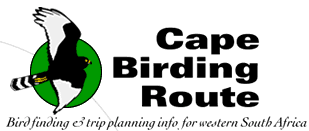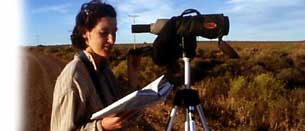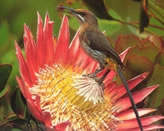| Kalahari
Gemsbok National Park:
This vast wilderness area offers the alluring combination
of abundant game, superb landscapes and good birding, all
within two-wheel drive access. The park is best known in birding
terms for its remarkable diversity and abundance of raptors,
including Bateleur, Red-necked and Pygmy
Falcons and Giant
Eagle Owl (p.116*). However, it also offers a number
of other often underestimated specials, among them Burchell’s
Sand-grouse (p.116*) and Pink-billed Lark.
Antelope such as Gemsbok (Oryx gazella) and Springbok
(Antidorcas marsupialis) are common, and the park is
also arguably one of the best places in the world to watch
hunting big cats, like Lion (Panthera leo) and particularly
Cheetah (Acinonyx jubatus). Spotted (Crocuta crocuta)
and Brown Hyenas (Hyaena brunnea) also occur. The latter
is actually the more common, but is rarely seen due to its
crepuscular habits.
In
1997, the Kalahari Gemsbok National Park was officially joined
to the Gemsbok National Park in adjacent Botswana to form
South Africa’s first Transfrontier Park, the Kgalagadi
Transfrontier Park, a vast conservation area spreading over
3.6 million hectares of the southern Kalahari. It is now possible
for visitors from South Africa to enter the Botswana portion
of the park, provided that they are equipped with four-wheel-drive
vehicles and have checked in at the Gemsbok/Bokspits border
post, 60 km south of Twee Rivieren (see Useful Contacts, p.136).
The
southern (South African) segment of the park forms a vast
triangle enclosed by the Namibian border in the west, the
Nossob River (also the Botswana border) in the north and east
and, approximately, the Auob River in the south. These two
rivers remain dry for decades on end, but are punctuated by
numerous artificial waterholes that concentrate the game along
the otherwise parched riverbeds. The principal roads in the
park run along the length of the two riverbeds; the only other
roads are two short-cut routes across the central dune sea
between the two rivers. The park roads are all unsurfaced,
but are well maintained and fully accessible to sedan cars.
The 260-km approach route from Upington is however tarred
for all but the final 60 km of its length. There are three
rest camps in the park: Twee Rivieren, at the entrance (the
southeastern extremity); Mata-Mata, on the Namibian border
in the far west; and Nossob in the north, halfway up the Nossob
River.
The
timing and length of your stay in the park will most likely
depend on the availability of accommodation (camping facilities
and very comfortable cottages are available in all the camps;
see p.136 for reservation details), and on your own priorities.
Because there are relatively few roads, and much of the park
is uniform in character, the exact sequence is not especially
important and the proposed route we describe below could be
executed in any order. This route is an optimal birding one
for those spending three to four nights in the park, and encompasses
an itinerary from Twee Rivieren northwards to Nossob (day
1) and possibly Union’s End (day 2), followed by an arc
southwest to the Auob riverbed via the central dune sea, before
returning to Twee Rivieren (day 2 or 3). Note that the drive
between the Twee Rivieren and Nossob rest camps is decep-tively
long — allow at least half a day without stops. Enquire
about current game-viewing conditions, and about the highly
recommended night drives that depart from both the Twee Rivieren
and Nossob rest camps about an hour before sunset. These make
for an atmospheric evening drive before the spotlights come
out for an exciting search for nocturnal birds and carnivores.
Allow
at least three and a half hours for the drive from Upington
north to Twee Rivieren. If you have time to spare, the Spitzkop
Nature Reserve just north of Upington is worth a brief visit
(see p.111). Sixty kilometres from Upington, the landscape
changes from open Karoo plains to sand, and the road takes
a roller coaster route over parallel dunes. Watch for Burchell’s
Courser (p.96*) and Black-eared
Finchlark (p.96*) along the initial Karoo expanses.
Northern Black Korhaan, Double-banded Courser
and, in wet years, Pink-billed Lark, are all likely
along the grassy dune sections of the road. Look out for the
occasional Pygmy Falcon, which is dependent on the
numerous Sociable Weaver
nests ingeniously attached to the telephone poles (see p.110).
Near
Andriesvale, 60 km south of the park, the road joins the confluence
of the Molopo and Nossob rivers, which are wooded with giant
camelthorn (Acacia erioloba) trees. This woodland,
especially near Molopo Lodge, offers good roadside birding,
including Lilac-breasted Roller and Golden-tailed
Woodpecker.
|


